by Michael Cropper | Jan 14, 2012 | SEO |
Recently I have had a few people ask me about how to get your own personalised image when commenting on blog posts so I thought I would write a bit of information on how to do this, as it is extremely simple. Below is a screenshot of what your blog comments will look like once you have completed the simple steps outlined in this blow post.

All you need to do so that your image will show next to all blog comments is to sign up to Gravatar (aka Globally Recognised Avatar – see where the name came from?). Within Gravatar you can personalise the image you would like to display and it is as simple as that!
Then next time you leave a comment on a blog post, the email address you have to enter when submitting a comment will be referenced with Gravatar and your image pulled in from there. Simple.

This technique works when commenting on all WordPress blogs and many other large blogs around the web. Great for branding yourself when commenting on blog posts.
So there you have it, a quick process which shows you how to get personalised images on blog comments.
by Michael Cropper | Dec 14, 2011 | SEO |
With all the recent Panda issues that Google has caused throughout 2011, they have recently announced a new tag that will help websites recover from a Panda penalty when they believe they have been incorrectly punished (aka Pandalised)
All you need to do to implement this ‘quick fix’ is to add the following meta tag to your website across all pages that have been impacted, between the <head> and </head> tags within your HTML. The next time Google crawls your website and can see the ‘no Panda penalty’ meta tag it will update its index accordingly and you should begin to see your rankings improve again.
<meta name=”panda” content=”no-penalty”/>
Here is what happened when I introduced this onto a site I have been working on. Sorry I cannot provide the website URL, so you will have to take my word for it. 
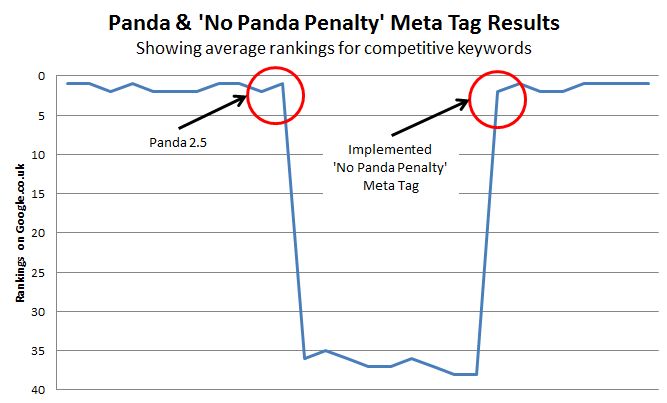
Wow! A full recovery from a simply one line change in the code.
Well if you have got this far reading the post, let me just add a small disclaimer. This post is a JOKE, so don’t go running to your developers asking them to implement this!
There have been a lot of stupid posts around the web recently about how websites have recovered from Panda by making silly little changes. Upon further looking at these they turn out to either be nothing valid since the site returned at another Panda update (ie, it was a tweak in the algorithm that caused the positive change opposed to any work they have done), or they won’t provide details about the website in question and the specific details/data behind their claim.
Sorry if I got your hopes up here about the ‘quick fix’ for Panda, but the reality is that to get your rankings back then you need significantly better content throughout your website. Check out the recent epic blog post I did about how to recover from Google Panda for some real advice.
by Michael Cropper | Dec 14, 2011 | SEO, Social Media |
One of my pet hates about websites is when they make it difficult or impossible to share their content on social media. Please webmasters & companies, come into the 21st century and understand how important sharing content is. Lets take a look through a few different websites and what sharing options they have on their site.
Websites With Poor Social Sharing Options
PC World
Looking at the product pages on PC World, the only options for a user are either to print or email the page. They are missing a massive opportunity by not including some of the more social buttons such as AddThis, Facebook Like button or the Tweet button.

Expedia
Expedia do a little better than PC World since they offer the ability to Like / Send buttons from Facebook, although what about if I want to share the content on Twitter or StumbleUpon?
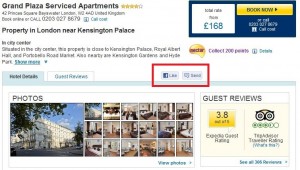
JJB Sports
JJB Sports have a better implementation of social sharing buttons than the previous websites listed as you can see below. They have included the AddThis button, Tweet button, Google Plus One button and the Facebook Like button. It doesn’t appear to have gained much traction so far since most of the products I viewed had no social shares, although I did only look through a handful of random product pages.

Google
With Google having recently launched their own social media platform, Google Plus, their Plus One button has been showing up everywhere and almost forcing people to begin to Plus One different websites. Here is an example of one of their Google Webmaster Guidelines posts and you can see that they have actually been nice to the other platforms (for a change!) and given users the ability to share the content on a range of platforms.
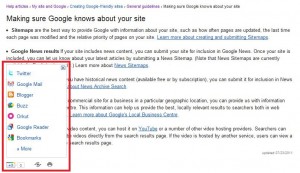
They have also integrated the Plus One button into the search results to try and get more people to use it, although more recently this has disappeared and will only appear when you mouse over a listing.

Whether you agree with how Google is pushing their own services or not, this is a good implementation of social sharing.
Website With Great Social Sharing Options
Now we can take a look at some websites who have nailed social sharing on the site, so much so that the number of shares their content gets of phenomenal.
SEO Book
SEO Book do a fantastic job of making social sharing buttons very visible, which is one of the reasons why their content is shared a lot. Below is an image of their recent blog posts and you can see it has had over 700 social shares, and likely many more which aren’t directly listed.
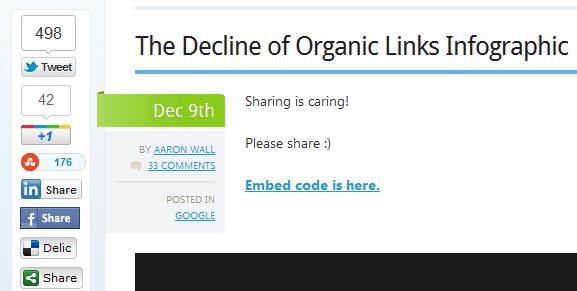
Search Engine Land
Search Engine Land do a good job of social sharing buttons as well, with the main sharing buttons placed above the story then additional sharing buttons offered by Share This at the end of the article. This way, the most frequently used buttons are easily identifiable without cluttering the page and the additional less used ones are still available.
Main social sharing buttons;

Other social sharing buttons at bottom of page;
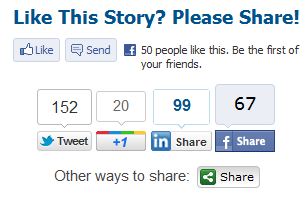
Search Engine Round Table
Search Engine Round Table also do a great job of social sharing in a very similar way to how SEO Book implement it. They also list the main social sharing buttons with the additional option to share more content via theAdd This button. The screenshot below was taken approximately 6 hours after the content was put online, so not bad to generate 60+ social shares within that time. I certainly couldn’t build that many links manually in such a short space of time!
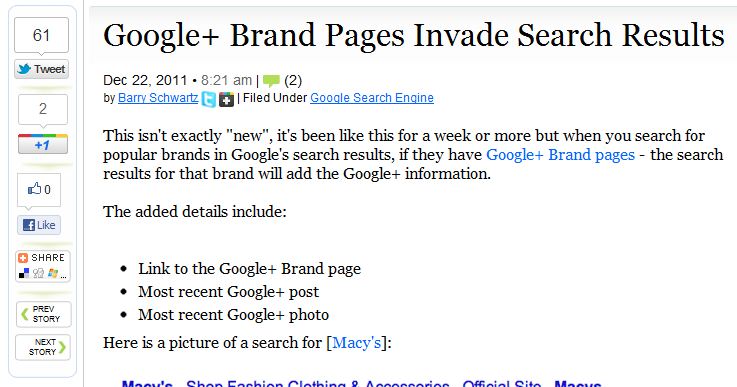
Hotels-London
Over at Hotels-London.co.uk we have recently introduced some fantastic (if I do say so myself!) social sharing options so a user can easily see how to share the content throughout the site. The image below is a toolbar which is always visible at the bottom of every page and allows customers to create nice friendly shortlists and view recently viewed hotels. Go check it out, its ace 

We also have the Add This button installed throughout the site in prominent places which allows the user to share via other popular social services.

Why Add Social Buttons?
If you website doesn’t excel at social sharing or you are still in doubt about why you need to be using social sharing buttons then here are some obvious tips about why you need to be promoting them;
- Social sharing helps promote your brand to more people FOR FREE. When a user shares the content on Facebook or Twitter, this content (and your brand) is then seen by all of their friends, family, followers and fans. Imagine the cost of trying to advertise to all of these people…
- By allowing people to share your content, they are likely going to come back and visit your website again. I personally use Twitter as a ‘read later’ list when I re-tweet random things that I spot. Other people will email things to their self for reading later at, generally when they spot something interesting (such as a nice holiday!) in works time and don’t want to get caught by their manager browsing this.
- Social signals help your SEO efforts!
- Social involves real people in the real world who are going to share and talk about your brand with other real people. The more real people you can get involved with your brand the better. This will ultimately lead to more sales, as long as people are talking about you for the right reasons!
- When someone has just purchased a product, left a review or commented on some content then they like to brag about it. Let them tell their friends about it, it will ultimately result in more people coming to your website.
Here is a great example illustrating the last point. The example is when you have purchased an item on Amazon.
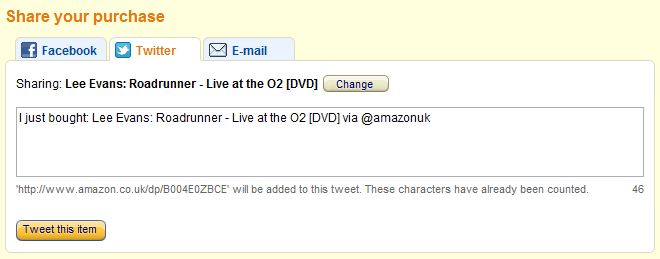
When it comes to link building, there are a couple of options
Option 1: Manually build low quantity and quality of links
Option 2: Build and promote great content which will attract natural links.
I certainly know which I would prefer to do. Get the great content and promote well, since this starts the ball rolling for content to be seen by many more people when it is shared over social media.
I hope this gives you something to go off and some good examples about the different options available. Most importantly is just getting something there at least, you can always improve on it later. For example, the Add This button takes literally less than 5 minutes to set up and install site wide. Just get it done. 
by Michael Cropper | Dec 14, 2011 | SEO |
As a search engine optimiser you will come across programming every day in one way or another and while it isn’t a must have skill for a lot of roles, I believe it is essential to be able to program and have a good understanding of programming in general.
Some SEO roles require you to get hands on with the code and make the changes straight away, where as within other roles the actual hands on work is completed by the technical team/department.
Either way here are a few reasons why I believe programming is an essential skill to have.
Improve Working Relationship with Developers
If you can speak the language of the developers then it goes a long way to building trust with them. It is important for developers to feel that the work they are doing is contributing to the wider business objectives, so by being able to speak in technical terms means you can bridge that gap between business requirements and technical implementations. I am not saying everyone needs to be an expert programmer or website developer but it is important to understand how things work.
If you don’t understand how things work then how can you go about making things better?
Working on several large scale multi-national travel websites has taught me that changes to the site are much easier to make once you understand how the site has been built. If you want to change the H1 or Meta Title on a selection of pages, then if you understand that the pages are built based on templates then this can help you devise a solution with the development team which allows you to make the required changes. Possibly some kind of mini content management system would be useful?

Understanding how to program also means that you don’t go asking for changes that are either impossible to achieve, that take a long time to implement and provide little or no return on investment.
For technical people, getting things right first time and developing code properly is what drives them. For non-technical people, they are at the opposite end of the spectrum and are only interested in the end product. To achieve a successful product it is important for all parties to work together and ensure that code is developed in a robust way and in a way that meets the original specification.
Whether you lean a bit of Java, PHP, C# or ASP.Net, it doesn’t matter since it gives you an understanding of how things work. It will help you have a real conversation about a technical problem and enable you to understand why seemingly simple changes can actually take a few days work. On the plus side, learning to program is fun too! 
Ability to use Macros in Excel
If you can program, then you will soon be able to pick up the programming language in Excel, VBA (Visual Basic for Applications). With this you can quickly develop tools which will make your job and your life much easier by automating the regular tasks or pulling in the required information quickly.
There are alternatives to using Macros in Excel, such as using Microsoft Access, but my preferred method is still traditional programming as it offers much more flexibility since you can integrate this information within a database.

Website Scraping
As a search engine optimiser I have no doubt that at some point in your career you have needed to scrape a lot of information from a certain website. Weather that be for price comparison, scraping data from the HTML or just playing around for fun. Website scraping can be done at a basic level using tools such as SEO Tools for Excel, but if you want the more juicy data then you really want to be able to put this into a database and either use on your own website or use it for further research.

To Spot The Rodney McKay
If you don’t anything about programming then when you get told by the technical team that something can’t be done because “the CSS file is located on an external server” you will have no knowledge to be able to question what has been said. You will find a Rodney McKay in every organisation who will say everything is impossible to fix, so they seem like a savior when they solve the problem that didn’t really exist in the first place!
Knowing your onions and being able to question things is extremely important.

Using APIs For Extra Data
There is a lot of data analysis within the SEO industry and some of this can include pulling in data from external sources such as Open Site Explorer via their API, Application Programming Interface. Some other APIs that you will no doubt use at some point will be the free Google APIs.
Whether that is using the KML API which is used for creating cool Google Maps visualisations or using the YouTube API to automatically post new content to YouTube when you add it to your website.
APIs can be an extremely powerful tool to use when joining bits of information together and connecting online applications and will certainly help your normal SEO efforts by taking the manual work out of things.

Summary
Take what you will from this long winded rant about programming, but I can strongly suggest learning to program and learning more about how ecommerce websites work in general. All of this knowledge is never lost and it will help you bridge the gap between marketing, external demand (ie search volumes on Google) and the technical team.
by Michael Cropper | Oct 14, 2011 | SEO |
There has been a lot of developments over the past few years with Google in the travel industry and their actions are ones I have been closely watching. With Google Hotel Finder launching earlier this year it is interesting to see how Google is changing.
When searching for hotels online there are two main categories of searches
- Destination searches such as London Hotels
- Hotel name searches such as The Lowry Hotel
So if we have a look at each of these to see how Google is handling these now we may get an idea of what lies in store in the next year or so.
Destination Searches
Looking at the search term Manchester Hotels we can see that there are several important parts to this.
Here we can see several parts to this section which are
- The link for “Places for hotels near Manchester” and “More results near Manchester”.
- The travel dates are listed
- A selection of individual hotel websites are listed
- Different recommended search terms related to “Manchester Hotels”
- Nearby locations
Lets take a look at each one of these and see how Google are handling this.
Places for hotels near Manchester
This is where the
link goes to.
As we can see above, there are what you would expect to see on any hotel aggregator website such as
- Hotel name
- Brief snippet of information (albeit a very poor snippet)
- Link to show where the hotel is located on a map
- Average rating of the hotel
- Number of reviews of this hotel
- Price of the hotel for today
When comparing this to some of the hotel aggregators, it seems Google has got a lot of the areas covered already. Hotel aggregators really need to step up in terms of innovation to ensure they are staying ahead of Google which is going to be quite a challenge.
Travel Dates Listed in SERPs
This is a great option for customers since this will automatically update the prices from various different hotel aggregators when the date is chosen.
Individual Hotels Listed
Again great for the user since this allows them to go direct to the hotel who may be able to deal with their queries better.
Related Search Terms and Nearby Locations
These ultimately send the user through the same process as above but with a more refined search.
Hotel Name Searches
Now if we have a look through the same process for hotel name searches to see how Google is handling these.
These listings within the SERPs are a first step towards integrating all of the universal search items into one nice area, which nicely takes up a large part of the results and is positioned prominently above everything else. Now for a user, this again does make sense to have the hotels listing first with other good content pulled together from various sources. My main issue with this though is that Google is notoriously bad at grouping things together like this and there is often a lot of errors with either images or reviews that are listed.
This listing has got all of the items that have been discussed but is just formatted in a nicer way. The interesting point will come when this switch is made from a listing like above to a similar listing like found on Google Hotel Finder as seen below
I have no doubt that this is on the cards for Google, it is just a matter of when they will do this or begin directing users towards their own Hotel Finder product.
How Much Can Google Reviews Be Trusted?
One item that Google has yet to work on though is the quality of the reviews left for hotels. Since there is no way of Google knowing if the person has actually stayed in the hotel and this is there hotel aggregators can stand out as they have the full booking details of the customer and know if they have stayed there. In addition hotel aggregators also have manual checking process in place to keep hotel reviews high quality.
As for how Google may overcome this issue, I am not sure yet. Although I imagine there will be some kind of information linked in with Google Plus in a very similar way of how Page Rank works. I.e. If the person leaving a review has an active Google Plus profile, lots of friends & followers and is also active on other Google products. This would be one way to class a reviewer as trustworthy or not. The same is on Twitter when it is obvious someone who has just began following you is a bot due to their statistics.
Is Google Going To Become a Competitor?
In a recent article from Marketing Week, apparently not.
“We have no intention of entering the booking space” – Google
Although I am not convinced. There are a lot of options open to Google in this industry and it is an extremely lucrative area for them, so only time will tell exactly what they will do. One thing for certain is that the travel industry needs to step up their game to compete against Google.



















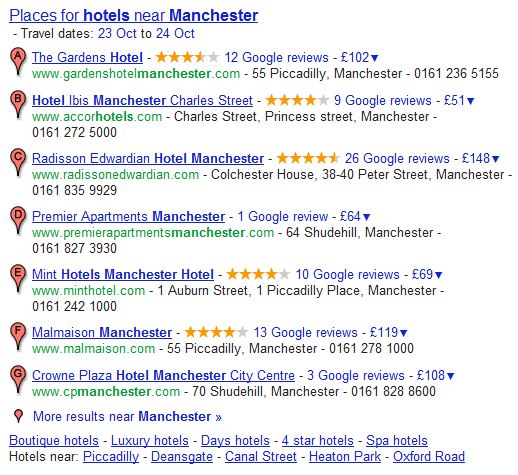
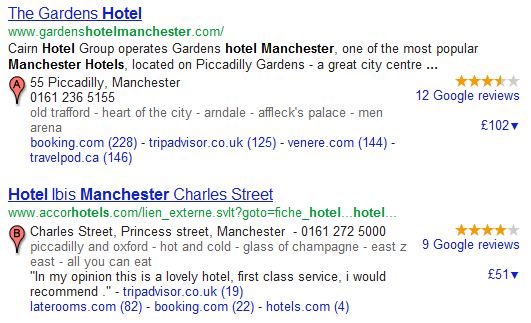
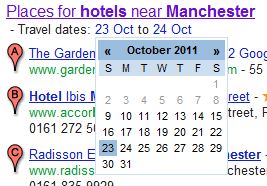

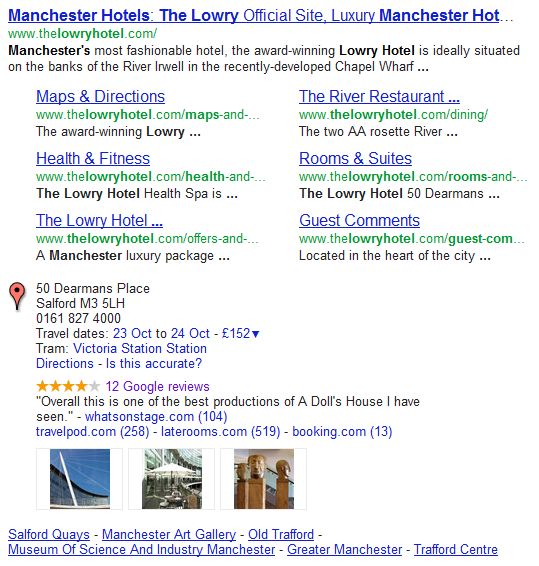

Does this actually work? I have tried this and it is not working so far.
…… ????
Panda is an iterative update, so maybe you just need to wait until the next iteration ????
< / joke >
(sorry, I just have to keep saying that this meta tag is a joke as I know there will be someone, somewhere, who will actually try to implement this thinking it will fix issues – hell, I have seen enough other crazy ideas around the subject, people will try anything!)
I just got Charlie Browned…*sad trombone*
Funny post.
Dave Stopher SEO… please tell me you didnt actually believe this you mug!